Russia is a vast country, with harsh weather and formidable landscapes. As the largest country in the world by landmass, Russia is home to many unique and interesting horse breeds.
From the former Soviet Union to the Russian Federation, Russia has a long and unique history. Over time, there are quite a few horse breeds that have developed in Russia. Some of the most fascinating Russian horse breeds include the Russian Don, Orlov Trotter, Russian Heavy Draft, Budyonny, Yakuitan, Kabarda, Russian Trotter, Vyatka, Tersk, and Bashkir.
Here are ten native Russian horse breeds.
1. Russian Don
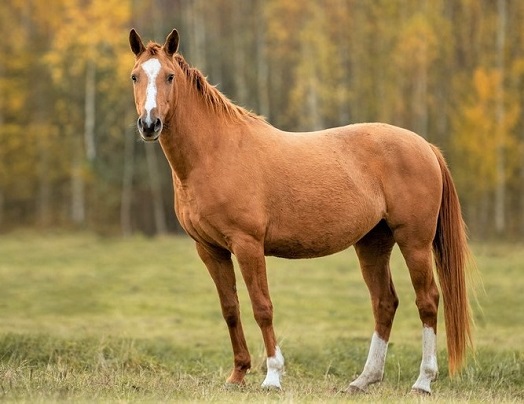
Rita_Kochmarjova / Shutterstock.com
Named after the region of Russia where the Don River flows, the Russian Don is one of Russia’s most prized breeds. With origins that trace back more than 200 years, the Don is the oldest continuously bred Russian riding horse.
Famous for their endurance and stamina, Don horses were the mount of choice for the Cossack cavalry. In fact, a Russian cavalry officer rode all the way from southern Russia to Paris on two Don mares in just 30 days during the Napoleonic Wars.
Though there were once thousands of Don horses, their numbers dwindled down to only a few hundred in the mid 20th century. Fortunately, today the Don breed was revived thanks to a successful breeding program.
Don horses have a refined head, straight neck, muscular chest, and strong legs. These elegant horses stand around 15-16 hands tall and are often chestnut, though they can also be bay, black or gray. Today, the Don horse is a popular endurance mount, as well as a harness horse.
2. Orlov Trotter
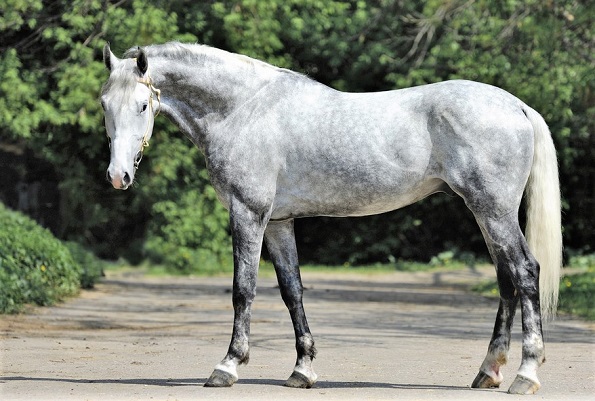
GeptaYs / Shutterstock.com
A Russian treasure, the Orlov Trotter is famous for its incredible speed and stamina. As the county’s most famous breed, they were once the fastest harness horses in Europe.
A.G. Orlov developed the Orlov Trotter at Khrenov stud sometime between 1775 and 1784. Orlov, who sought to develop a light harness breed that could tolerate Russia’s tough climate, crossed Arabian horses with Dutch, Danish, and Mecklenburg harness breeds.
After careful breeding, the stud produced the great stallion Bars I. The beautiful gray stallion passed his excellent conformation and swift trot to his offspring, creating the Orlov Trotter breed. Orlov was protective over his stock and it wasn’t until 20 years after his death that stallions were openly sold to private stud-owners.
As a versatile breed, the Orlov Trotter has many uses including harness racing, combined driving, carriage driving, and riding. They have a refined head, arched neck, muscular body, and powerful legs. These exquisite horses often stand between 15.2-17 hands tall and are generally gray, though they can also be bay, black, or chestnut.
3. Russian Heavy Draft
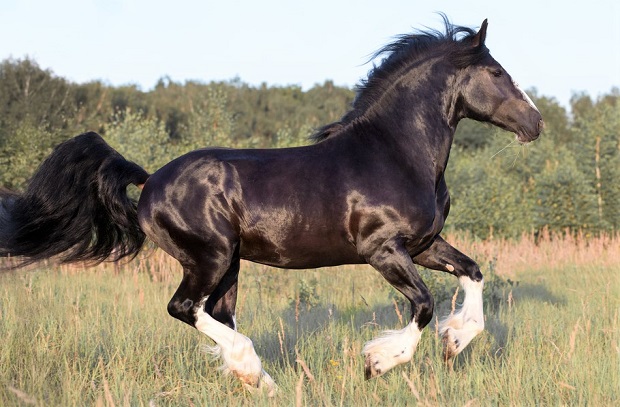
Olga Vasileva / Shuttertsock.com
The Russian Heavy Draft horse became an official breed in 1952, however, the breed’s origins go all the way back to the 1860s. These robust horses have been popular choices in Russia for agricultural work thanks to their powerful builds.
The Russian Heavy Draft was developed by crossing Russian-bred grade mares with Orlov Trotter, Percheron, and Ardennes stock. In addition to its draft characteristics, the breed is notable for its milk-producing capabilities. Kumys, which is fermented mare’s milk, is a long tradition in southern Russia and the steppes of Central Asia as a medicinal tonic.
Russian Heavy Draft horses are small yet powerful horses with a heavy cob conformation. Standing between 14.1- 15 hands, they have a strong, well-arched neck, muscular body, and lightly feathered legs.
Typically, they are strawberry roan or chestnut, though they can also be bay in color. These docile horses were primarily used for farm work and pulling carriages.
4. Budyonny

Zuzule / Shutterstock.com
Named after Marshall Semyon Budyonny, the Budyonny horse was developed as a military horse following the Russian Revolution. As the country’s calvary stock had become depleted, Budyonny set to work to create a military riding horse.
The Budyonny breed was created by crossing Russian Dons with Chernomor mares and Thoroughbred stallions. The first Budyonny horses were known as Anglo-Dons and they were bred with the foundation stock. The stock consisted of 657 mares that were Anglo-Chernomor, Anglo-Don, and Anglo-Don/Chernomor crosses.
Once the breed was established, Budyonny horses were used as cavalry mounts during WWII. Thanks to their braveness, stamina, athleticism, and willingness to please, they were reliable war mounts. After the war, they became popular sport horses.
Today, the breed’s uses include dressage, jumping, endurance, driving, eventing, and driving. Budyonny horses have an athletic build with a well-muscled body and wide chest. These elegant horses stand between 15-16 hands tall and are most commonly chestnut, though they can also be bay, gray, brown, or black.
5. Yakutian

Tatiana Gasich / Shutterstock.com
The Yakutian is a hardy horse breed native to the Yakut region of Russia in Siberia. Also called the Yakut horse, they are one of the oldest and most unique breeds of horse.
Yakuitan horses are able to withstand subzero temperatures that other horse breeds would not be able to. They have evolved to survive the brutal winters of Siberia, where temperatures can drop as low as -40 degrees Fahrenheit. In just a span of 800 years, this incredible breed has undergone morphologic, metabolic and physiologic adaptations.
Yakutian horses are extremely hardy with small, compact builds, standing between 12- 14 hands and coming in a variety of colors. Locals to the region have long relied on these horses for transportation, milk and even in some cases, meat. Yakutian horses grow long, shaggy coats during winter similar to that of Woolly Mammoths.
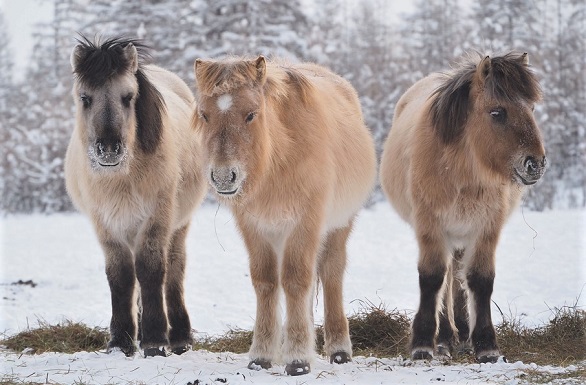
andzher / Shutterstock.com
During winter, the Yakutain’s hair can reach eight centimeters long and is extremely dense, which is unlike any other breed. During the winter, they exhibit standing hibernation, where they reduce their metabolism while staying on their feet. They are the only horse breed to possess this unique capability, thus we included them in our list of 8 unusual horse breeds.
During fall they create fat reserves and by spring they are able to increase their carbohydrate metabolism. Scientists even believe they are capable of reducing the volume of circulating blood when temperatures become frigid in order to avoid frostbite.
6. Kabarda
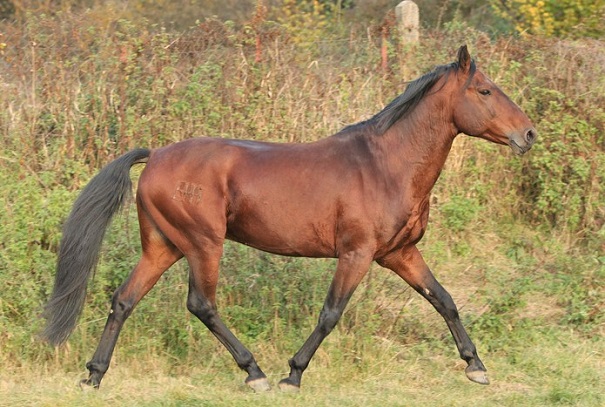
Zuzule / Shutterstock.com
Kabarda horses have been around for at least 500 years, but it is quite possible the breed is much older than that. Since the 16th century, tribesmen in the northern Caucasus have selectively bred Kabarda horses.
During their development, other breeds such as the Turkoman, Arabian, and Karabakh influenced the Kabarda. The tribesman developed a breed that was capable of surviving in the tough mountain conditions that other breeds would struggle in.
Within the Kabarda breed, there are three subtypes: basic, oriental and massive. The basic type is a standard Kabarda horse that is a rangy mountain riding horse. The oriental type exhibits more of the Arabian influence, with finer legs and a hotter temperament. Within the massive type, the horses are longer bodied and bigger boned, with a more robust build.
At one point, Kabarda horses were facing extinction, but a German breeder stepped in to help preserve the breed. Kabarda horses are incredibly sure-footed and agile, making them reliable pack horses, as well as riding and driving horses. Standing at 15-16 hands tall, they are often bay or black and have a muscular build with strong hooves.
7. Russian Trotter
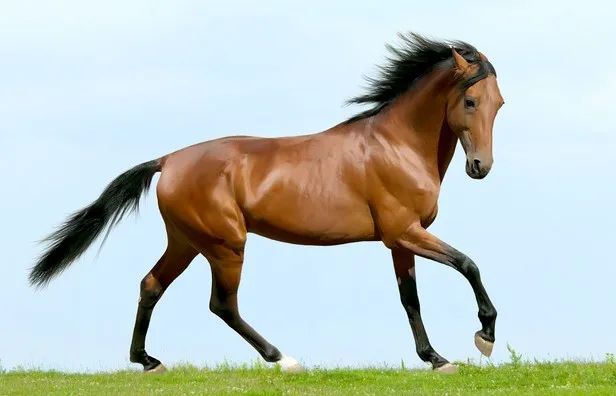
Edoma / Shutterstock.com
Despite being a relatively new breed, the Russian Trotter is now one of the most common breeds within Russia. Though the development of the breed began in 1890, it wasn’t until 1949 that they gained official recognition.
The Russian Trotter is a result of crossbreeding between Orlov Trotters and Standardbreds. Standardbreds were imported from America, attracting breeders due to the fact they were faster than Orlov Trotters. Until 1914, 156 stallions and 220 purebred mares took part in the breeding program.
After WWI and the Civil War, Russia stopped the import of Standardbreds. This affected the development of the breed, as the American Standardbreds/Orlov Trotter crosses were either bred among themselves or bred back Orlovs. However, by 1949 Russian Trotters had achieved favorable characteristics from both breeds.
In the 1960s, more Standardbreds had been imported to increase the speed of the Russian Trotter. Today, they specialize in harness racing, pleasure driving, and riding.
Russian Trotters have a straight head and well-muscled body, standing around 16 hands tall. They are generally bay, black, chestnut, or gray in color.
8. Vyatka
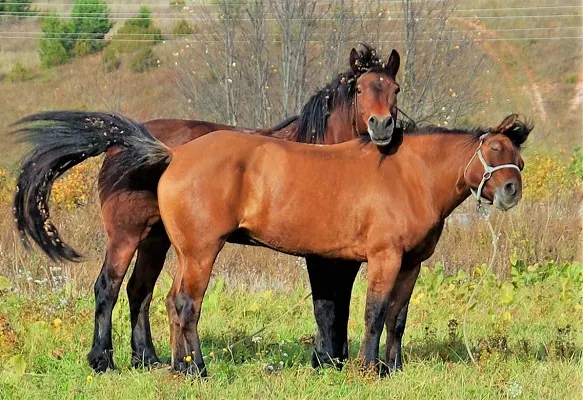
Smolll / Shutterstock.com
The Vyatka is an endangered breed of horse native to the Vyatka region of Rusia, which now is the Kirov Oblast. The climate and terrain of their native land played a key role in their development.
The development of the Vyatka was influenced by native Estonian breeds that were brought over by Novgorod colonists in the 14th century. These resilient horses adapted to the cold, snowy winters and rocky terrain of the region. The native people relied on them for agriculture and riding.
With the mechanization of agriculture in the 20th century, the number of Vyatka horses plummeted. Those dedicated to the breed made efforts to preserve the breed and by 1980, there were 2,000 horses. However, today the breed’s numbers are less than 1,000.
The Vyatka has been a popular choice for troika racing in Russia, a sport in where three horses are harnessed side by side, often to a sleigh. They have a stocky, compact build with a well-arched neck and muscular body.
Vyatka horses stand between 13-14 hands tall and are often dun in color with primitive markings, though they can also be bay, roan, brown, chestnut, or black.
9. Tersk

Olga_i / Shutterstock.com
The Tersk horse was developed at Tersk and Stavropol studs in the North Caucasus region of Russia from the 1920s to the 1940s. Though they are a relatively new breed, these beautiful horses are now considered endangered.
Tersk horses were developed from Arabian, Strelets, Arab-Don, and Strelets-Kabarda stock. The goal while breeding was to create a horse that was as smart as an Arabian with the same type but larger in stature.
Also read: 6 types of purebred Arabian horses
After careful breeding, the Tersk gained official recognition in 1948. The breed has five sire lines and five mare lines. Most of the population comes from Stavropol Stud.
Tersk horses have an elegant head similar to an Arabian, a high set neck, and an athletic body. They stand around 15 hands tall and are often a beautiful silvery gray in color, though they can also be bay, chestnut, or black.
Thanks to their excellent athleticism and even temperament, Tersk horses excel in endurance, dressage, and jumping.
10. Bashkir
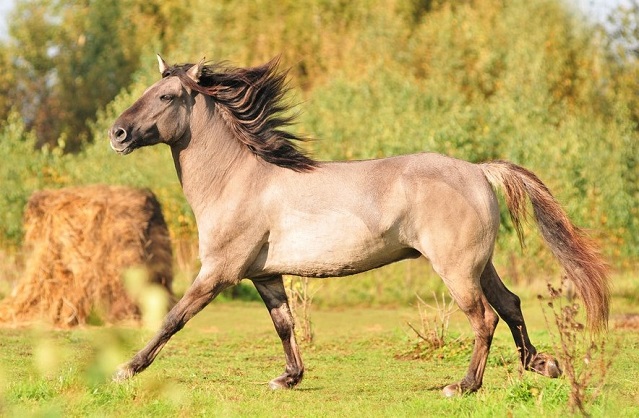
Olga_i / Shutterstock.com
The Bashkir horse is native to the Bashkortostan region of Russia. Though they closely resemble the American Bashkir Curly, they are different breeds.
The Bashkir is an ancient breed that has been bred for centuries by the Bashkiria people. Though their origin is unknown, many believe they trace back to steppe horses of West Asia. Over time, other breeds such as the Russian Heavy Draft, Kazakh and Yakut horses have been crossed with the Bashkir.
Bashkir horses exhibit a long coat that often is curly. There are types of Bashkir horses: mountain type and steppe type. The mountain type is a smaller, draft type and the steppe type has a taller, lighter build.
Standing between 13-14 hands tall, Bashkir horses have a deep chest, short legs, and small stature. They come in many colors including bay, gray, chestnut, roan, and dun. These hardy horses have many uses including farm work, riding, driving, and pack work. Many locals also drink the milk of Bashkir mares.
Honorable Mention: Akhal-Teke
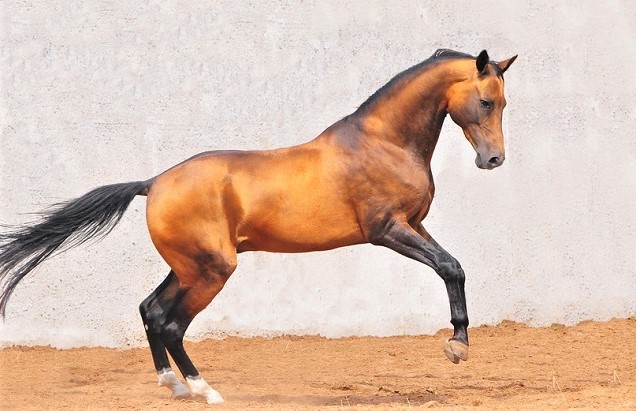
Olga_i / Shutterstock.com
Though the Akhal-Teke breed originates from Turkmenistan, they have a heavy Russian influence. In 1881, Turkmenistan was under the rule of the Russian Empire and Akhal-Tekes became a popular horse across Russia.
The Russian general Kuropatkin grew to love these spectacular hoses he saw while fighting the tribesmen. He decided to establish a breeding farm after the war, renaming them the Akhal-Teke. The Russians closed the studbook in 1932 and published it in 1941.
The Akhal-Teke is one of the oldest horse breeds in the world, tracing back to over 3,000 years ago. These exquisite horses stand out for their athleticism, endurance, and distinctive metallic coats. They are able to adapt to harsh desert climates.
Akhal-Teke horses have lean, athletic builds, with refined heads. They make stellar sport horses, as they compete in jumping, dressage, and eventing. In addition, they are also great endurance mounts and are even popular racehorses in Turkmenistan.
Often referred to as “Golden Horses” Akhal-Tekes are famous for their distinctively metallic, shiny coats. Their unique coat is a result of their unusual hair structure. They come in different colors including black, bay, chestnut, buckskin, cremello, palomino, perlino, and gray.
Source: horseyhooves.com








